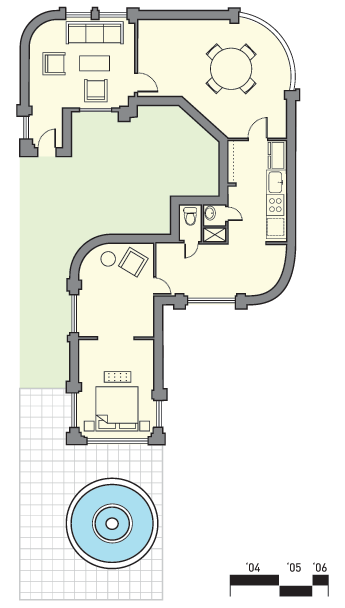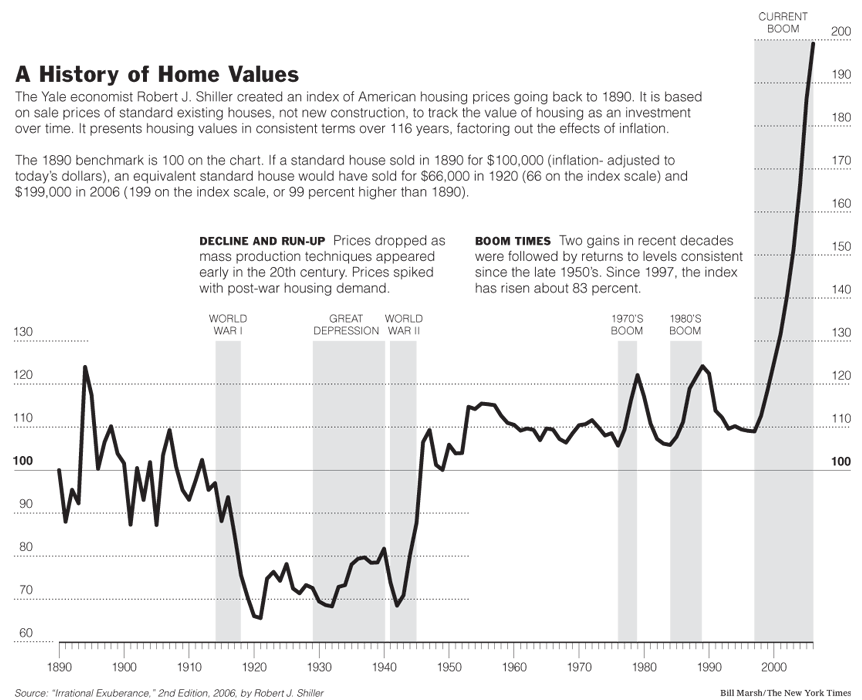| Want to send this page or a link to a friend? Click on mail at the top of this window. |
More Special Reports |
| Posted August 28, 2006 |
| Read Between All Those For-Sale Signs |
 |
Julia Hoffmam |
By DAVID LEONHARDT |
and VIKAS BAJAJ |
R EAL bubbles pop. They are fully formed one moment and gone the next. Financial bubbles rarely meet with such a definitive end, which has always been the biggest problem with the metaphor. They let out their air in unpredictable bursts, and it’s usually impossible to figure out whether they have finished deflating or are just starting to.
Still, the latest housing numbers seem like they could be a turning point. A real estate crash might not be the most likely outcome, but it certainly seems legitimate to think about what one would look like.
The number of building permits being issued is falling at a rate usually seen only in recessions. In July, 11 percent fewer existing homes were sold than were sold a year earlier; 22 percent fewer new houses were sold. After the new-house data was released last week, Capital Economics, a consulting firm, wrote an e-mail message to its clients that began, “New day, same depressing housing market story.”
The fate of the housing market will influence whether the economy will merely slow over the next year, as the Federal Reserve forecasts, or fall into a recession for the first time since early 2001. Lehman Brothers, the investment bank, said Friday that “for-sale” signs had replaced gas-price signs as the most important indicator of potential trouble.
The collapse of most bubbles does not have a single obvious starting point, like a bad corporate earnings report or an interest-rate rise. Instead, the psychology of buyers and sellers shifts, slowly at first and then sometimes in a cascade.
| A soft landing, a long slump, or a hard crash: What path will the slowing housing market take? |
“It’s always mystified people about why these things turn,” said Robert J. Shiller, a Yale economist and author of “Irrational Exuberance,” a history of speculation. “People want something concrete.”
There seem to be three major paths that housing could follow over the next year: a soft landing, the start of a long slump, or a crash. A soft landing is the one predicted — and preferred — by most economists on Wall Street and at the Fed. A long slump is what many past real estate booms turned into. A crash is the outcome that a small group of analysts say is the only possible ending for the biggest housing boom of all.
Their prediction looks better than it did a few weeks ago, but even they aren’t sure whether this is the beginning of the end or another false turning point. “The funny thing about bubbles,” Mr. Shiller said, “is that you never know when they’re over.”
For a crash to happen, prices would have to decline significantly in some once-hot markets. So far, as sales have slowed and the number of houses on the market has soared, many owners have chosen to sit tight. If they were instead to decide that selling later would be even worse than selling now, this could change quickly.
The doomsayers’ strongest argument may be that too few families can afford prices in some metropolitan areas. In Las Vegas, Los Angeles and Miami, prices have almost doubled since 2003, and they have risen about 50 percent in New York and San Francisco, the National Association of Realtors says.
Jumps of this magnitude have little precedent. To afford homes, some buyers, especially in California, have resorted to aggressive mortgages, like those that allow artificially low payments in the early years. In effect, families seem to be buying houses they cannot afford, in the hope that their incomes or property values will rise significantly. “Prices just shot up too much,” said Robert T. McGee, chief economist at U.S. Trust, an investment firm based in New York. The firm has forecast a soft landing for housing, he said, but “as time goes by that starts to look like wishful thinking.”
If prices do decline, some of the first victims would be families in a financial bind that are unable to rescue themselves by refinancing their mortgage. Foreclosures would then rise, damaging banks and increasing the number of homes for sale.
Even homeowners not in danger of losing their home — an overwhelming majority, certainly — might respond to falling prices by cutting spending, particularly if they had been counting on their home’s value to serve as a retirement account. That could force job cuts in a wide range of industries.
Already, the housing slowdown has begun damaging the job market. Builders, mortgage lenders and real estate agencies have stopped adding to payrolls. Defined broadly, the real estate sector has accounted for 44 percent of jobs created since 2000 and employs more than one in 10 American workers, according to Moody’s Economy.com.
Perhaps the biggest reason to be skeptical about a real estate crash is that the country has not really suffered through one before. Not since the Depression has the combined value of residential real estate fallen over the course of a full year. Homes seem to be much less vulnerable to crashes than other assets, because people rarely sell them in a panic.
But earlier booms have been followed by modest price declines in some cities that turned into long periods in which increases trailed inflation. After peaking in much of California and the Northeast in the late 1980’s, house values fell during the recession of 1990-91 and then drifted for years, often rising more slowly than the price of milk.
In inflation-adjusted terms, prices in the New York and Washington areas did not return to their late-80’s peak until 2002. In Boston, it didn’t happen until 2000, and in San Francisco, 1999.
 |
It isn’t hard to imagine a similar chain of events over the next decade. Based on futures contracts traded on the Chicago Mercantile Exchange, investors expect the median house price in Los Angeles, New York and some other regions to fall about 5 percent in the next year, which would be similar to the decline that started the 90’s slump.
From there, prices might start rising again, but at a slow enough pace that incomes would eventually catch up. Families that now need an exotic mortgage to buy a house in Los Angeles could eventually afford one the old-fashioned way.
Interest rates could play a role in a long slump, too. They have been falling for much of the last decade, helping push house prices higher by allowing buyers to afford bigger mortgages. Most economists expect rates to remain lower than they were a generation ago but not to return to the extremely low levels of a few years ago, making big swings in house prices, in either direction, unlikely.
Christopher J. Mayer, director of the Paul Milstein Center for Real Estate at Columbia University, argues that the recent drop in sales does not suggest that a larger bust is coming. “So far we have only seen people asking pie-in-the-sky asking prices and not getting them,” said Mr. Mayer, who expects housing to continue slowing but not enough to create a recession.
He believes that the boom in house prices was largely a result of the appeal of “superstar cities” like New York and San Francisco that are unlikely to lose their allure. In much of the rest of the country, prices are not unusually high, considering the relatively low interest rates.
Moreover, few borrowers are falling behind on their mortgage payments, and the economy looks fairly healthy outside of housing. So if prices start falling, new buyers may jump into the market and prevent any extended slump. “The fundamentals of real estate are solid, still,” said James Gillespie, chief executive of Coldwell Banker, the real estate company.
Which is it, then — a brief pause, or a big correction?
“Either argument is very compelling. I can debate myself on it,” said Mark Zandi, chief economist at Moody’s Economy.com. “That’s why there’s a great deal of uncertainty.”
Copyright 2006 The New York Times Company. Reprinted from The New York Times, Week in Review, of Sunday, August 27, 2006.
| Wehaitians.com, the scholarly journal of democracy and human rights |
| More from wehaitians.com |